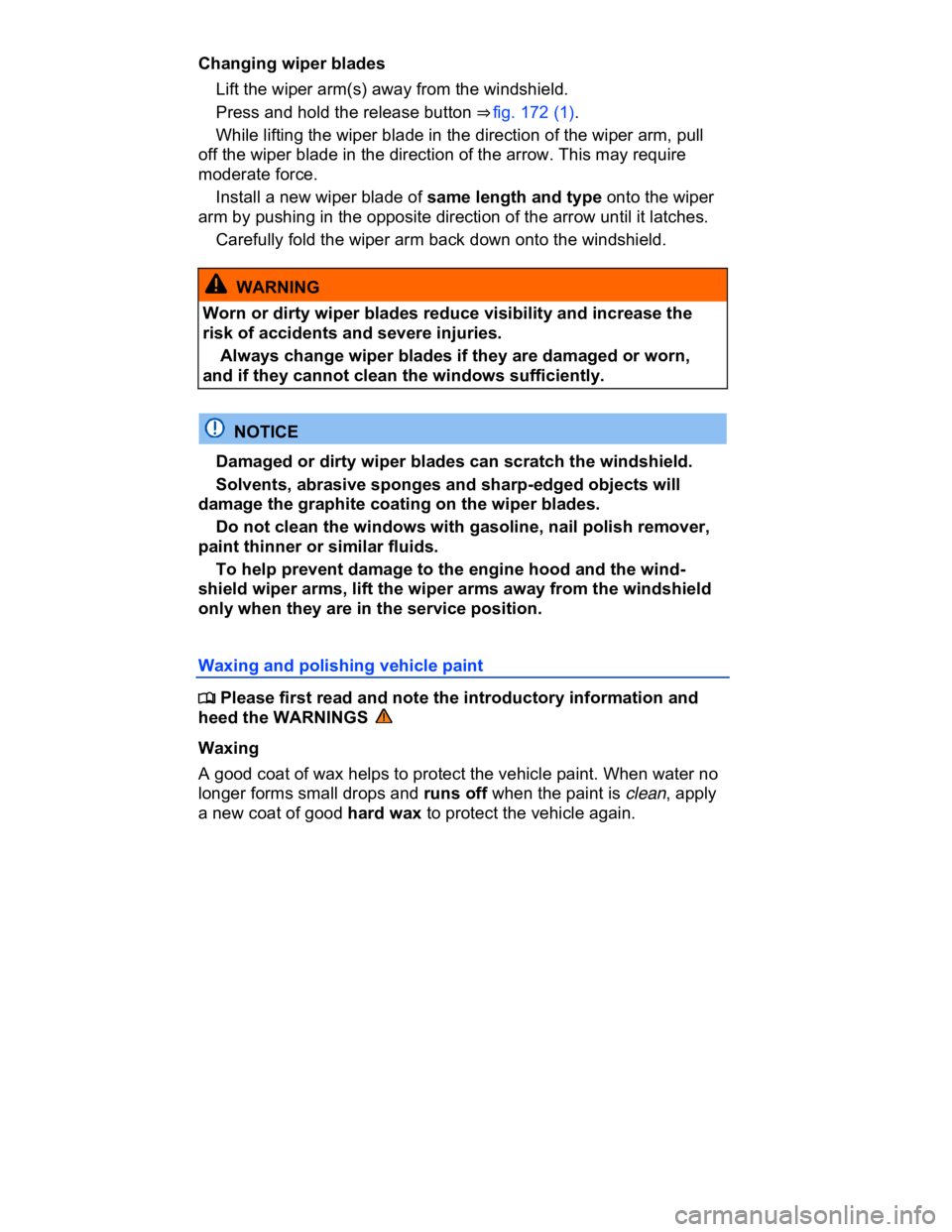Page 166 of 578
NOTICE
To help prevent damage to the wiper blades and the wiper motor
when it is cold outside, always make sure that blades are not
frozen to the windshield before operating the wipers. Using the
windshield wiper service position can be helpful in cold weather
so the wipers do not freeze to the windshield ⇒ Windshield wip-
er service position.
Indicator light
�
Page 168 of 578

frozen to the windshield before operating the wipers. Using the
service position can be helpful in cold weather so the wipers do
not freeze to the windshield ⇒ Windshield wiper service posi-
tion.
� If the ignition is switched off while the wipers are running, the
wipers will continue at the same wiping speed when the ignition
is switched on again. Frost, ice, snow, leaves, and other objects
on the windshield can damage the wipers and the wiper motor.
� Remove snow and ice from the wipers before you begin driv-
ing.
� If the wiper blades freeze to the windshield, loosen them care-
fully. Volkswagen recommends using a deicing spray.
NOTICE
Never switch on the windshield wipers when the windshield is
dry because the windshield can be scratched.
The windshield wipers work only if the ignition is switched on and
the engine hood is closed. The windshield wipers turn off automatical-
ly when the engine hood is opened.
The intermittent wiping for the front windshield depends on the
driving speed. The higher the speed, the faster the wipers move.
If the wiper blades freeze to the windshield, loosen them careful-
ly. Volkswagen recommends using a deicing spray.
Windshield wiper functions
�
Page 172 of 578

Push the lever into the desired position ⇒ fig. 94:
(A) Rain sensor off (windshield wiper lever home position).
(B) Rain sensor active – automatic wiping as needed.
(1) Adjusting the sensitivity of the rain sensor:
– Move switch to the right – high sensitivity.
– Move switch to the left – low sensitivity.
After switching the ignition off and back on again, the rain sensor
stays on and works again with the wiper lever in position (B).
Possible reasons for changes in the way the rain sensor works
The rain sensor may misread what is happening in the detection zone
of its sensitive rain-sensor surface ⇒ fig. 95 (arrow) and not work for a
number of reasons, which include:
� Worn out wiper blades: Worn out wiper blades may leave a film of
water or wiping streaks; this can cause the wipers to run longer, to
wipe more often, or to wipe continuously at high speed.
� Insects: Insects hitting the sensor may trigger the wipers.
� Salt streaks: Salt streaks on the windshield from winter driving can
cause wiping more often or continuously on glass that is almost dry.
� Dirt: Caked-on dust, wax, any other buildup on the windshield (lo-
tus effect), or car-wash detergent residue can lower the rain sensor's
sensitivity and cause it to react too slowly or not at all.
� Crack or chip in the windshield: If a stone hits and chips the wind-
shield while the rain sensor is on, this will trigger a wiper cycle. After
that, the rain sensor will recognize the change and recalibrate itself to
respond to the sensitive surface's reduced detection zone. Depending
on the size of the chip, the sensor's reaction pattern may or may not
change.
WARNING
The rain sensor cannot always recognize rain and activate the
wipers.
� Switch the wipers on manually when water on the windshield
reduces visibility.
Clean the rain sensor's sensitive surface ⇒ fig. 95 (arrow) regular-
ly and check the wiper blades for wear or damage.
Page 457 of 578
NOTICE
To help prevent vehicle damage in a car wash:
� Compare the vehicle track width with the dimensions of the
guide rails in the car wash to help prevent damage to wheel rims
and tires!
� Switch off the rain sensor before driving the vehicle through a
car wash ⇒ Rain sensor.
� Make sure there is enough clearance for the height and width
of the vehicle.
� To help prevent paint damage to the engine hood, place wiper
blades against the windshield after they have dried. Do not let
them snap back into place.
� Fold the outside mirrors toward the vehicle body. Do not fold
power folding mirrors manually!
� Lock the luggage compartment lid to help prevent uninten-
tional opening in the car wash.
Washing with a power washer
�
Page 461 of 578
Cleaning and changing the windshield wiper blades
Fig. 172 Changing the windshield wiper blades.
�
Page 462 of 578

Changing wiper blades
� Lift the wiper arm(s) away from the windshield.
� Press and hold the release button ⇒ fig. 172 (1).
� While lifting the wiper blade in the direction of the wiper arm, pull
off the wiper blade in the direction of the arrow. This may require
moderate force.
� Install a new wiper blade of same length and type onto the wiper
arm by pushing in the opposite direction of the arrow until it latches.
� Carefully fold the wiper arm back down onto the windshield.
WARNING
Worn or dirty wiper blades reduce visibility and increase the
risk of accidents and severe injuries.
� Always change wiper blades if they are damaged or worn,
and if they cannot clean the windows sufficiently.
NOTICE
� Damaged or dirty wiper blades can scratch the windshield.
� Solvents, abrasive sponges and sharp-edged objects will
damage the graphite coating on the wiper blades.
� Do not clean the windows with gasoline, nail polish remover,
paint thinner or similar fluids.
� To help prevent damage to the engine hood and the wind-
shield wiper arms, lift the wiper arms away from the windshield
only when they are in the service position.
Waxing and polishing vehicle paint
�